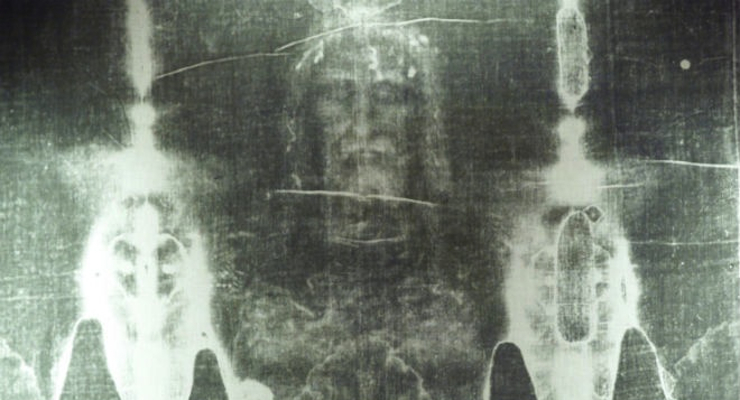

The Shroud of Turin is is believed to be the burial cloth of Jesus, revealing the face of Christ as it was impressed in a strip of linen. (PHOTO: CORBIS IMAGES)
A new study examining the Shroud of Turin, an artifact disputed to be either a medieval forgery or the true burial shroud of Jesus Christ, revealed interesting results.
“Individuals from different ethnic groups and geographical locations came into contact with the Shroud [of Turin] either in Europe (France and Turin) or directly in their own lands of origin (Europe, northeast Africa, Caucasus, Anatolia, Middle East and India),” study lead Gianni Barcaccia, a geneticist at the University of Padua in Italy and lead author of the new study describing the DNA analysis, told Live Science. “We cannot say anything more on its origin.”
Barcaccia and colleagues analyzed dust particles that were vacuumed off of the shroud, which revealed traces of both plant and human DNA. The plant DNA surprisingly came from all over the world, including European spruce trees, Mediterranean clovers, ryegrasses, plantains, North American black locust trees, rare East Asian pear and plum trees all left their mark on the cloth.
Yet, by their own admission, the study revealed nothing about the legitimacy of the Shroud of Turin. Legend says the actual shroud of Jesus was secretly carried from Judea in A.D. 30 or 33, and was kept in Edessa, Turkey, and Constantinople (the name for Istanbul before the Ottomans took over) for centuries. Crusaders sacked Constantinople in A.D. 1204, which was then the capital of the Eastern Roman Empire, and the shroud was smuggled to Athens, Greece, where it stayed until A.D. 1225.
The Catholic Church has only officially recorded its existence in A.D. 1353, when it showed up in a tiny church in Lirey, France. In the 1980s, radiocarbon dating, which measures the rate at which different isotopes of the carbon atoms decay, suggested the shroud was made between A.D. 1260 and A.D. 1390, lending credence to the notion that it was an elaborate fake created in the Middle Ages. However, researchers later argued that small parts of the clothe tested were replacements sown by nuns after the shroud was in a fire.
Geologists further cite the Gospel of Matthew that states “the earth shook, the rocks split and the tombs broke open” after Jesus was crucified, leading them to argue an earthquake at the time of Jesus’ death could have released a burst of neutrons that would’ve thrown off the radiocarbon dating and resulted in the darkened imprint on the shroud.
The team also sequenced the human mitochondrial DNA (DNA passed from mother to child) found in dust from the shroud. The genetic lineage, or haplotype, of the DNA snippets suggested that people ranging from North African Berbers to East Africans to inhabitants of China touched the garment.
Still, the strongest genetic signals seemed to come from areas in and around the Middle East and the Caucasus — not far from where Jesus was buried, and consistent with the early folklore surrounding the object.
“One of the most abundant human mitochondrial haplotypes, among those discovered on the shroud, is still very rare in western Europe, and it is typical of the Druze community, an ethnic group that has some origin in Egypt and that lives mainly in restricted areas between Syria, Jordan, Lebanon, Israel and Palestine,” Barcaccia told Live Science in an email. “In my opinion, it is hard to believe that in the past centuries, in a historical interval spanning the medieval period, different subjects — such as priests, monks or nuns, as well [as] devotees and other subjects of Indian ancestry — have had the possibility to come in contact with the shroud in France and/or Turin.”
Of course, that’s just his opinion.
But the new results don’t settle questions about the shroud’s authenticity, said Hugh Farey, editor of the British Society of the Turin Shroud newsletter. [Who Was Jesus, the Man?]
As far as the plant DNA goes, “they’ve done a good job, and they’ve identified a number of species that mean, broadly speaking, nothing at all,” Farey told Live Science.
The new study suffers from the same issues that made past studies of pollen on the shroud unreliable, said Renée Enevold, a geoscientist at the Moesgaard Museum in Denmark who has analyzed ancient pollen in the past.
“The plant DNA could be from many sources, and there is no way of finding the right source,” Enevold told Live Science in an email. “Also, the sub-genus level of taxon that has been reached is not near enough to the species level that is needed to determine the area of origin for each plant.”
The researchers also mistakenly relied on an interpretative method that is used to analyze thousands of grains of pollen in a lake, she said. In that environment, the conditions that led to the deposition of pollen — rain and wind, for instance — are known. In contrast, there are so many unknowns when it comes to describing how dust settled onto the shroud.
“It is very bold and completely wrong to use the same interpretational approach on the presence of DNA — or just a few pollen grains, for that matter — on a shroud that has been man-handled for decades,” Enevold said.
Given that the cloth was publicly displayed for centuries, it’s not surprising that so many people touched it, Farey added. “Apart from ruling out the United States of America as the source for the shroud, it leaves just about everything else open,” Farey said.
Even Farey estimated he’s only 40% convinced the shroud is the true burial shroud of Jesus Christ, and roughly 60% on the side it’s a forgery.
“There is a pretty substantial amount of evidence on both sides,” Farey said. “So the proper thing to do is to maintain an open mind at the moment.”








Heff / September 9, 2017
Are there any cloths such as this one from the 1300s in existence today?
/